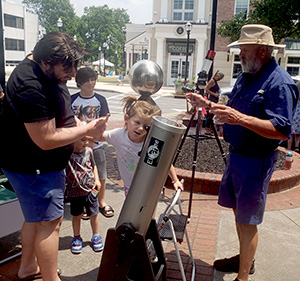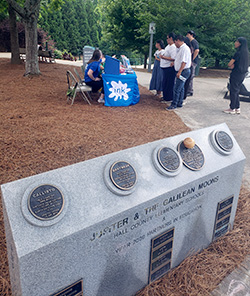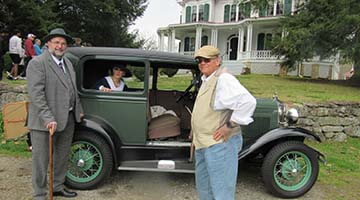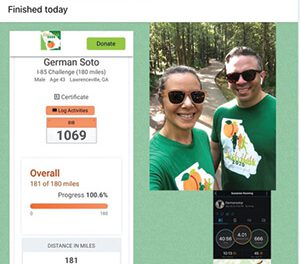
Robert Webb, on of the founders of the Scale Model of Our Solar System, assists star trekkers safely viewing the real Sun on a Hydrogen-Alpha telescope.
Newcomers, visitors and some long-time Gainesville residents cruising close to the Sun downtown occasionally see that shiny orb and wonder why it’s situated on the southeast corner of the square. Last month both the curious and the familiar gathered at the city’s vibrant center to learn more about the unique scale model of the solar system that extends from the Sun to the dwarf planet Pluto at Longwood Park on Lake Lanier.
On Star Trek Discovery Day/Galaxy Quest June 10 a collaboration of downtown promoters, nature lovers and community partners hosted a journey on the 1.8-mile path dotted with monuments to the celestial spheres. At least a couple hundred trekkers from the metro-Atlanta area and nearby communities footed it between the planets and learned a thing or two along the way.
At the origin, Robert Webb, one of the Scale Model Solar System Trail’s founders, focused a hydrogen-alpha telescope on the real Sun and recalled how the mini-solar system tour originally launched. The North Georgia Astronomy Club designed, raised money and installed the monuments in The Millennium Project begun in the 1990s. They planted Earth on the square on Dec. 31, 1999, a symbolic gesture.
“Thanks to the Prince song, ‘Party Like It Is 1999’ most people thought the new millennium started on January 1, 2000,” Webb said. “The other planets on the Gainesville Square were installed that first week of 2000. We had hoped to have the rest of the scale model of our solar system installed by the real start of the millennium on January 1, 2001, but it was April of that year before everything was in place.”
Webb, a retired University of North Georgia astronomy professor who directed planetarium programs at the college, has led skyward-looking sessions with Elachee Nature Science Center. In the first years of the Millennium, he led monthly tours of the mini-solar system. “What was surprising to a lot of people is what’s most unique about it: the distances and sizes are correct” to scale, he said.
The Gainesville path from the square through three parks en route to Longwood Cove offers one of 13 “to scale” solar system trails in the world, said Deb Gravitt, Gainesville Welcome Center Manager. The city’s Convention & Visitor’s Bureau teamed up with Elachee Nature Science Center to re-launch interest in the unusual local attraction.
“It seems that fewer people know about it now than they did in decades past. We agree, this is part of the catalyst for having an event rather than just creating and printing a map,” Gravitt said. For years the tourism department has printed maps and posted an internet page about the trail, “but people come in all the time and don’t know about it,” she added. “We continue to have guests that come to the welcome center and request the map as well as many teachers and homeschoolers. However, with so many new people moving into our community, part of the reason for this event is to bring back awareness.”
Besides viewing sunspots safely through a telescope with Webb, space tourists also viewed replicas of constellations in a mini-star lab set up in the Brenau Downtown Center. Amy Bradford, Elachee Director of Operations who also serves on the Gainesville CVB board, said the inflated mini-planetarium filled to its 25-person capacity for each 30-minute slot in the 4½ hour event. Bradford and Welcome Center First Impressions Manager Lauren Shubert brainstormed the whole event, invited other community partners, and were on site to get folks into orbit.
During the family friendly day-time hours, Mallory Pendleton, Headwaters Outreach Manager of Chattahoochee Riverkeeper, posted a CRK banner near Earth and talked about the planet’s main component: water. Kids colored filters with chalk and drenched them to make suncatchers. Families collected stickers and bookmarks from an Interactive Neighborhood for Kids booth just across from Jupiter at Veterans Park. Northeast Georgia History Center set up a tent near the entrance of Ivy Terrace Park, near Uranus, to look back in time at constellations and celestial bodies.

Just west of Jupiter and the Galilean Moons, star trekkers visit guides from the International Neighborhood for Kids.
At the Downtown Gainesville Branch of the Hall County Library, between Mars and the Asteroid Belt, children created space-themed crafts and listened to “Blast-off” story time.
As evening fell, adult space mongers mingled for Galaxy Quest, which included drink specials like Galaxy Swirl wine slushies, Lightyear Lemonade, Celestial Sangria, and Milky Way Mocha from tap rooms and merchants around the square. Gen Xers merged with Baby Boomers and Millennials to pack the star lab and channel van Gogh in the Starry Night Painting Workshop at the library. Both programs filled up.
“I’m loving it,” said local Girl Scout troop leader Rachel Gibson, whose charges marked the path with chalk. She raved about the “great atmosphere” of fun and learning on the trail. Elizabeth Gonzales, who walked to the square from lonely Pluto near the lake, said she had occasionally spied a planet or two, but did not know much about the mini-solar system. “This is a nice way to learn about the planets,” she said.
Webb envisions trekkers experiencing a trail-inspired epiphany. “My hope is by experiencing the scale model a person will have a renewed vision of how small and how unique and how alone and how amazing our planet Earth is, and how this lone small planet is the limit of our resources and somehow we must wisely allot them to sustain life not just for our current millennium, but for thousands of millenniums into the future,” he said.
Gravitt deemed Star Trek a success and is hopeful there will be a sequel, maybe even a fundraiser to replace some of the planet models that thieves and vandals have snatched through the years. “The mission of this event was to bring back awareness of our Solar System trail and it did,” Gravitt said. “All of our partners felt it was a positive experience.”
A lot has happened since Webb and a group of amateur astronomers installed the solar system to herald the new millennium. The astronomy club dissolved years ago. “It was a product of the last century to bring like-minded people together to help each other improve their observing skills and share their telescopic views of the universe with others,” Webb said. The internet replaced in-person help sessions. “Even Star Parties had reduced attendance as more viewing was done via computer-controlled cameras,” he said.
Eight years after the Sun’s shiny surface first sparkled, an economic recession darkened the Downtown Square. Empty buildings surrounded the orbs. A few night spots, shops and restaurants kept their lights on. Eventually, new stores, eateries and tap rooms opened up. Gainesville eased its alcohol restrictions, updated infrastructure, and revamped streetscapes. The local economy blasted off with new residential accommodations and niche shops. The Midland Greenway inched along, transforming blighted former industrial grounds into a pedestrian playground with watering holes and eateries. Gainesville is again having its day in the Sun.
Photos: by Jane Harrison







